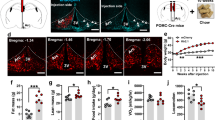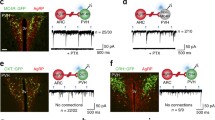Abstract
DOMINANT alleles at the agouti locus (A) cause an obesity syndrome in the mouse, as a consequence of ectopic expression of the agouti peptide1–6. This peptide, normally only found in the skin, is a high-affinity antagonist of the melanocyte-stimulating hormone receptor (MC1-R)7, thus explaining the inhibitory effect of agouti on eumelanin pigment synthesis. The agouti peptide is also an antagonist of the hypothalamic melanocortin-4 receptor (MC4-R)7–9. To test the hypothesis that agouti causes obesity by antagonism of hypothalamic melanocortin receptors7, we identified cyclic melanocortin analogues10 that are potent agonists or antagonists of the neural MC3 (refs 11, 12) and MC4 receptors. Intracerebroventricular administration of the agonist, MTII, inhibited feeding in four models of hyperphagia: fasted C57BL/6J, ob/ob, and AY mice, and mice injected with neuropeptide Y. Co-administration of the specific melanocortin antagonist and agouti-mimetic SHU9119 completely blocked this inhibition. Furthermore, administration of SHU9119 significantly enhanced nocturnal feeding, or feeding stimulated by a prior fast. Our data show that melanocortinergic neurons exert a tonic inhibition of feeding behaviour. Chronic disruption of this inhibitory signal is a likely explanation of the agouti obesity syndrome.
Similar content being viewed by others
References
Klebig, M. L., Wilkinson, J. E., Geisler, J. G. & Woychik, R. P. Proc. Natl Acad. Sci. USA 92, 4728–4732 (1995).
Bultman, S. J., Michaud, E. J. & Woychik, R. P. Cell 71, 1195–1204 (1992).
Kucera, G. T., Bortner, D. M. & Rosenberg, M. P. Dev. Biol. 173, 162–173 (1996).
Perry, W. L., Hustad, C. M., Swing, D. A., Jenkins, N. A. & Copeland, N. G. Genetics 140, 267–274 (1995).
Wilson, B. D. et al. Hum. Mol. Genet. 4, 223–230 (1995).
Miller, M. W. et al. Genes Dev. 7, 454–467 (1993).
Lu, D. et al. Nature 371, 799–802 (1994).
Gantz, I. et al. J. Biol. Chem. 268, 15174–15179 (1993).
Mountjoy, K. G., Mortrud, M. T., Low, M. J., Simerly, R. B. & Cone, R. D. Mol. Endocrinol. 8, 1298–1308 (1994).
Hruby, V. J. et al. J. Med. Chem. 38, 3454–3461 (1995).
Gantz, I. et al. J. Biol. Chem. 268, 8246–8250 (1993).
Roselli-Rehfuss, L. et al. Proc. Natl Acad. Sci. USA 90, 8856–8860 (1993).
Wolff, G. L. Genetics 48, 1041–1058 (1963).
Al-Obeidi, F., Castrucci, A. M., Hadley, M. E. & Hruby, V. J. J. Med. Chem. 32, 2555–2561 (1989).
Watson, S. J., Akil, H., Richard, C. W. & Barchas, J. D. Nature 275, 226–228 (1978).
Jacobowitz, D. M. & O'Donohue, T. L. Proc. Natl Acad. Sci. USA 75, 6300–6304 (1978).
Huszar, D. et al. Cell (in the press).
Bergendahl, M., Wiemann, J. N., Clifton, D. K., Huhtaniemi, I. & Steiner, R. A. Neuroendocrinology 56, 913–920 (1992).
Brady, L. S., Smith, M. A., Gold, P. W. & Herkenham, M. Neuroendocrinology 52, 441–447 (1990).
Steiner, R. A., Kabigting, E., Lent, K. & Clifton, D. K. J. Neuroendocrinol. 6, 603–608 (1994).
Wilding, J. P. H. et al. Endocrinology 132, 1939–1944 (1993).
Erickson, J. C., Hollopeter, G. & Palmiter, R. D. Science 274, 1704–1707 (1996).
Stephens, T. W. et al. Nature 377, 530–532 (1995).
Schwartz, M. W. et al. J. Clin. Invest. 98, 1101–1106 (1996).
Kestersan, R. A., Huszar, D., Lynch, C. A., Sinerly, R. S. & Cone, R. D. Mol. Endocrinol. (submitted).
Johnson, R. A. & Salomon, Y. Methods Enzymol. 195, 3–21 (1991).
Chen, W., Shields, T. S., Stork, P. J. S. & Cone, R. D. Anal. Biochem. 226, 349–354 (1995).
Laursen, S. E. & Belknap, J. K. J. Pharmacol. Methods 16, 355–357 (1986).
Author information
Authors and Affiliations
Rights and permissions
About this article
Cite this article
Fan, W., Boston, B., Kesterson, R. et al. Role of melanocortinergic neurons in feeding and the agouti obesity syndrome. Nature 385, 165–168 (1997). https://doi.org/10.1038/385165a0
Received:
Accepted:
Issue Date:
DOI: https://doi.org/10.1038/385165a0
- Springer Nature Limited
This article is cited by
-
Alterations of serum neuropeptide levels and their relationship to cognitive impairment and psychopathology in male patients with chronic schizophrenia
Schizophrenia (2024)
-
Glial cell changes in the corpus callosum in chronically-starved mice
Journal of Eating Disorders (2023)
-
Evaluation of the MC3R gene pertaining to body weight and height regulation and puberty development
Scientific Reports (2023)
-
The melanocortin action is biased toward protection from weight loss in mice
Nature Communications (2023)
-
Increased intrinsic and synaptic excitability of hypothalamic POMC neurons underlies chronic stress-induced behavioral deficits
Molecular Psychiatry (2023)





